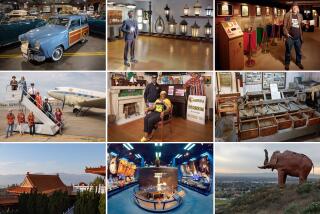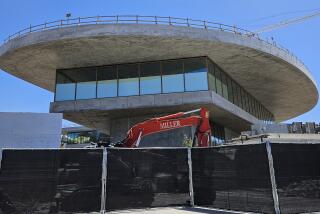Holocaust Museum Imperiled
- Share via
Masha Loen had her share of close calls as a child--she was 14 when Nazis yanked her out of a boxcar and tossed her into a concentration camp, where her mother and two sisters were executed.
Sixty years later she is facing another one: the threatened closure of a museum she helped create to honor victims of the Holocaust.
Financial problems are jeopardizing the future of the Los Angeles Museum of the Holocaust, the nation’s oldest memorial of its type to victims of Adolf Hitler’s atrocities.
The museum’s paper-thin operating budget has been cut in half. And volunteers and part-time employees who run it have been told it could shut down by the end of the year if new financing isn’t found.
The museum at 6006 Wilshire Blvd. was established in 1961 by Holocaust survivors as the “Martyrs Memorial Museum.” Its artifacts, photographs and exhibits starkly trace the tragic plight of Jews who were seized and persecuted by Nazis during World War II.
But since 1993 the modest museum has all but disappeared into the shadows of its bigger and wealthier cousin, the high-tech, highly promoted Museum of Tolerance, a few miles away at 9786 W. Pico Blvd.
Whereas the glitzy, newer museum uses interactive and electronic exhibits, the Museum of the Holocaust relies on more traditional glass-case displays, photographic blowups and models arranged in a ground-floor corner of a converted office building.
The Holocaust museum has been kept afloat by the Los Angeles Jewish Federation, an umbrella group for local Jewish organizations.
That agency has had its own financing problems, however. Just as it embarks on an emergency $10-million fund-raising campaign to help Israel, the federation also is coping with $3million in cutbacks from its own $43-million budget.
The effect on the museum was immediate. Its operating budget was slashed from last year’s $120,000 to $60,000. In contrast, the museum was allocated $189,000 in 1999-2000, according to its operators.
“My fear is the museum will close. We’re pretty darn close,” said Rachel Jagoda, its director, who is paid to work only 15 hours a week. “Our rent is paid until December. If we can’t raise our rent for next year--$90,000--we’re gone.”
Holocaust museum operators say they harbor no ill will against the Museum of Tolerance. Operating on an $8-million annual budget, it is run by the Simon Wiesenthal Center and has a paid staff of about 50.
“They have an incredible educational program. It’s a youth-oriented museum,” Jagoda said of the rival museum. “Ours is a lot more historical in nature. But I think our problem is a lot of people don’t know we’re even here.”
While the Museum of Tolerance has a $9 admission fee ($5.50 for students), the Holocaust museum is free. About 500 schoolchildren a month visit, compared with 1,000 students a day who tour the Museum of Tolerance.
“We like the intimate atmosphere here,” said Sharon Gebhart, a Venice High School teacher helping escort several dozen students through the Museum of the Holocaust last month.
Volunteer Harry Drotow of Park La Brea, whose father was a Nazi prisoner, led the tour after youngsters discussed the Holocaust with survivor Erika Jacoby, 73, of Valley Village.
Tamara Aguilar, 16, cried as Jacoby spoke. “We’d read about the Holocaust, but she really got to me,” the 11th-grader said afterward. “My ancestors went through slavery and were chained to boats. I’m glad I met her.”
Jewish Federation officials say the museum’s future could depend on how it strengthens its connection with schools. It is important “that the museum demonstrate there are a lot of kids going through there and being touched by the program,” said Michael Hirschfeld, director of the federation’s community relations committee.
Hirschfeld said he said he hopes wealthy Holocaust survivors will chip in and buy the Wilshire Boulevard building and donate it to the museum.
“There are some very comfortable people in the survivor community who could make that museum take off,” Hirschfeld said.
Museum board of directors Chairman Dr. Gary Schiller, a hematologist and oncologist at the UCLA Medical Center, said he is looking for a $1-million endowment for the museum.
“We think we cannot function with 1 1/2 employees. We cannot rely on elderly volunteers,” Schiller warned.
If that is not possible, then officials might want to consider moving the museum to the San Fernando or Conejo valley, “where you have half the [Jewish] population” of the Los Angeles area, suggested John Fishel, president of the federation.
“Will you be successful reaching more people with two museums like these in close proximity? I doubt it,” Fishel said.
But others think there is space for both the Holocaust museum and the Museum of Tolerance in Los Angeles. Liebe Geft is one. She’s the director of the Museum of Tolerance.
The Holocaust “truly warrants as many fine institutions as possible,” Geft said. “There’s room for many more than two. This is a very large metropolis. We encourage everyone to embrace the challenge of teaching” and combating historical revisionists who claim that the Nazi atrocities never took place.
Those at the Holocaust museum agree.
“This is a lot more modest than the Museum of Tolerance, but it tells a story that must be told,” said museum visitor Peter Rothholz, an advertising executive who divides his time between homes in Santa Monica and East Hampton, N.Y.
Nearby, security guard Michael Aust--who is not Jewish--was answering the phone and scheduling school tours between arranging chairs and greeting visitors. He said the museum deserves to survive.
“I see grown men leave here in tears,” Aust said. “Teenagers come in swaggering, and this place humbles them. They walk out of here without the swagger.”
A nearby display case contains the only surviving photograph of Masha Loen’s family. Loen, of Valley Village, donated it after helping lead a fund-raising campaign 20 years ago that helped pay for the exhibits.
Her mother and sisters died at the concentration camp at Stutthof. It would be tragic, she said, for survivors’ dreams of a permanent memorial to die on Wilshire Boulevard.
More to Read
The biggest entertainment stories
Get our big stories about Hollywood, film, television, music, arts, culture and more right in your inbox as soon as they publish.
You may occasionally receive promotional content from the Los Angeles Times.











